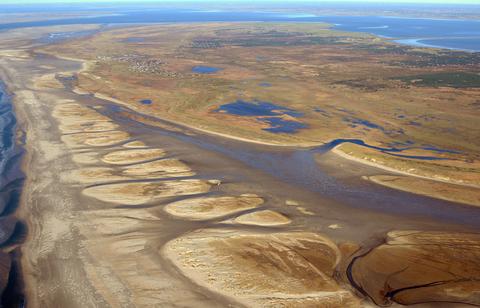






Protecting and managing the site
The Wadden Sea is a natural area of global importance shared by three countries. At the same time, the Wadden Sea is surrounded by a significant population. Therefore, the continued priority for the protection and conservation of the Wadden Sea is an important feature of the planning and regulation of use, including within land/water- use plans.
Key threats requiring ongoing attention include fishery activities, harbours, industrial facilities and maritime traffic, residential and tourism development and climate change. The southern North Sea is also intensively used by the shipping industry and the Wadden Sea area is influenced to a major extent by these international activities. Thus, safety and ships’ safety are extremely relevant for the protection of this sensitive sea area.
Working together in the “Trilateral Cooperation on the Protection of the Wadden Sea”, Germany, the Netherlands and Denmark have managed and protected this valuable ecosystem since 1978. Today, almost the entire Wadden Sea coast is protected as national parks and nature reserves. The management system is a combination of the national management systems and the trilateral Wadden Sea Plan (WSP) implemented by the responsible authorities. The Guiding Principle of the Trilateral Wadden Sea Cooperation is to “achieve, as far as possible, a natural and sustainable ecosystem in which natural processes proceed in an undisturbed way”.

Photos: Natural dynamics (sands, flats, islands or salt marshes) (Photo: John Frikke)
- Trilateral Cooperation on Protection of the site
-
The three countries bordering the Wadden Sea, Denmark, Germany and the Netherlands, make up the Trilateral Wadden Sea Cooperation (TWSC) which was established in 1978. The main decision-making body of the Cooperation is the Ministerial Council, which meets every three years. The ministers discuss Wadden Sea matters, and provide political leadership, harmonisation and decision-making between the three governments.

Ministerial Council 2014 / and Minsters Signing Tønder Declaration 2014The cooperation is governed by the Wadden Sea Board representing the three governments, which meets twice a year. It runs and oversees the work of the Cooperation between the Ministerial Council meetings, and prepares, adopts and implements the Strategy for the work of the Cooperation. It appoints Task Groups and other expert groups to prepare and to undertake specific tasks, plans or projects.
The Common Wadden Sea Secretariat (CWSS) coordinates, promotes and facilitates the work of the Trilateral Cooperation. It was established in 1987 and is located in Wilhelmshaven, Germany.
More information at : http://www.waddensea-secretariat.org/about-us
The Cooperation is based on the “Joint Declaration on the Protection of the Wadden Sea”, which was first signed in 1982 and then updated in 2010. The Joint Declaration is a declaration of intent, and includes the objectives and areas of the cooperation and the institutional and financial arrangements.
The Trilateral Wadden Sea Plan (WSP) is the common policy and management plan for the protection and sustainable management of the entire Danish-Dutch-German Wadden Sea Area. It is also the foundation upon which the Outstanding Universal Value of the property is being preserved in addition to its legal protection on national and state levels. Activities that are incompatible with its conservation have either been banned, or are heavily regulated and monitored to ensure they do not impact adversely on the Wadden Sea.
A unique and basic feature of the Wadden Sea Plan is that it aims to achieve the full scale of habitats, that belong to a natural and dynamic Wadden Sea. Each of these habitats, for which common trilateral Targets have been adopted, needs a certain quality (natural dynamics, absence of anthropogenic disturbance, absence of pollution), which can be achieved by proper management of the area.
The overall aim of the Wadden Sea Plan is to implement the objectives of the Trilateral Wadden Sea Cooperation, as laid down in the Joint Declaration, i.e.
a. a natural ecosystem, its functions and characteristic biodiversity;
b. resilience to climate change and other impacts;
c. maintenance of the landscape and cultural heritage;
d. sustainable use as defined by the Convention on Biological Diversity and the Habitats Directive;
e. public support for the protection of the Wadden Sea.Link to (in English only): http://www.waddensea-secretariat.org/management/wadden-sea-plan-2010
Downloads
Trilateral Wadden Sea Plan 2010 and Joint Declaration
Wattenmeerplan 2010
- National protection and management of the Wadden Sea
-
Denmark
The Danish Wadden Sea is protected through comprehensive provisions of the Statutory Order on the Wadden Sea Nature and Wildlife Reserve, municipal planning and administration of the international protection areas in the Wadden Sea region. In 2010, the Danish Wadden Sea National Park was established. It is responsible for the implementation of the National Park Plan, which contains guidelines and objectives for the National Park’s nature, landscape and cultural heritage values.
More information at: danmarksnationalparker.dk/vadehavet/
Germany
In Germany, the coastal federal states of Schleswig-Holstein, Hamburg and Niedersachsen are in charge of the implementation of the Federal Nature Conservation Act which sets the framework for establishing nature reserves and national parks.
The World Heritage Site includes three national parks: the National Park Schleswig-Holsteinisches Wattenmeer (established 1985), the National Park Hamburgisches Wattenmeer (established 1990) and the National Park Niedersächsisches Wattenmeer (established 1986). The main objectives of the national parks are to protect the Wadden Sea and to allow natural processes to take place with a minimum degree of disturbances and other detrimental effects of human activities. The national park authorities are responsible for the management and implementation of the National Park Act.
More information at: www.nationalpark-wattenmeer.de
The Netherlands
In the Netherlands, protection combines a unique national physical planning approach, the Key Planning Decision Wadden Sea, 3rd Policy Document Wadden Sea (PKB, since 1980), with a designation of the Wadden Sea under the Nature Conservation Act 1998, supported by additional designation such as the Flora and Fauna Act. Together with the Ecological Main structure (EHS), they form the basis for protection and management of the Dutch part of the Wadden Sea.
The PKB defines the overall objectives of conservation, management and use of the Wadden Sea and is binding for all state, regional and local authorities.
- EU Legislation
-
The European Union legislation in the field of the environment is of specific significance for the Wadden Sea and has increased in importance during the past two decades. Of the comprehensive list of environmental legislation, the Birds and Habitats Directives, forming the Natura 2000 network, and the Water Framework and Marine Strategy Framework Directives are the most relevant ones.
- International agreements
-
The Wadden Sea is further covered by a number of international agreements, conventions and treaties such as the Ramsar Convention (Convention on Wetlands of International Importance), the Convention on Biological Diversity (CBD), the Convention on the Migratory Species (CMS), the Agreement of the Conservation of African-Eurasian Waterbirds (AEWA), the Agreement on the Conservation of Small Cetaceans in the Baltic, North East Atlantic, Irish and North Seas (ASCOBANS), the Convention on the Conservation of European Wildlife and Natural Habitats (Bern Convention) and the Convention for the Protection of the Marine Environment of the North-East Atlantic (OSPAR).

